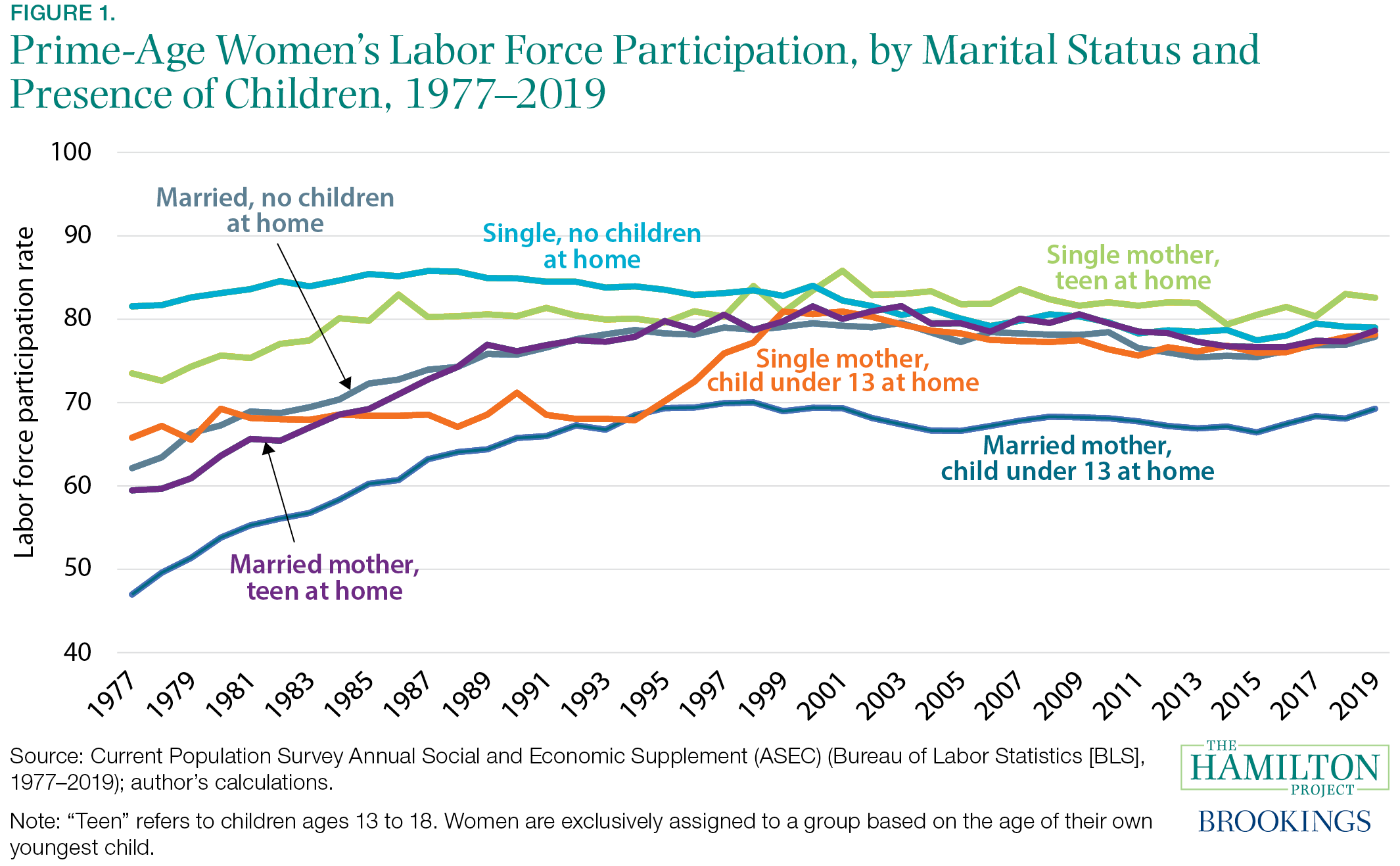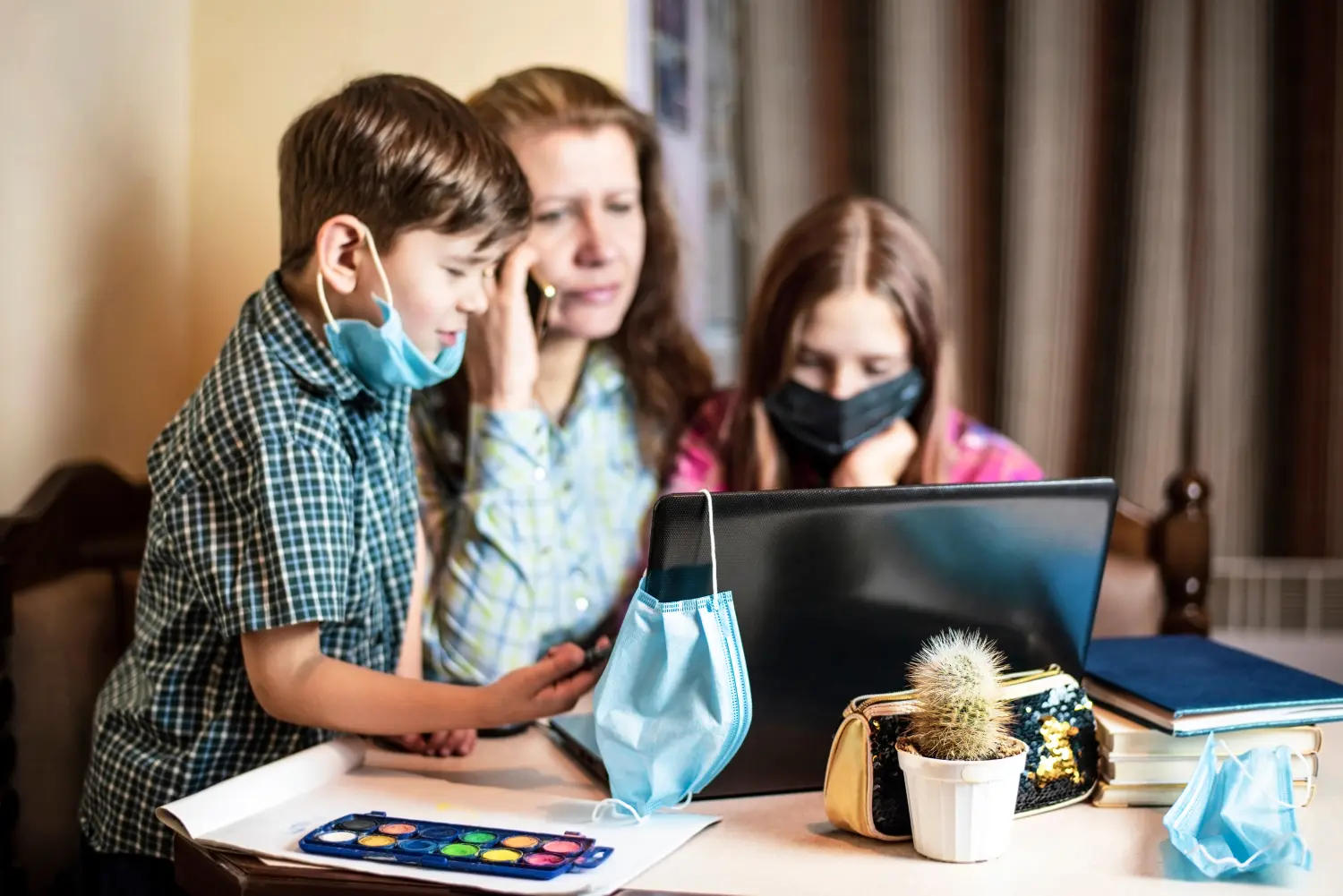Fact 1: Through 2019, labor force participation rates of prime-age women had converged, with the exception of married mothers of young children.
Figure 1 shows labor force participation rates (LFPRs) for women by marital status and by the age of the mother’s youngest child: whether they have a young child (a child under 13 years old), a teenager (a child aged 13–18), or no children at home. While 2019 did not mark a peak in participation for any of these groups, we note several trends.
First, the LFPRs of single mothers with young children have followed a similar pattern to others since the mid-1990s. Notably, single mothers with young children made a ten percentage point jump (from 70.2 to 80.6 percent) in their LFPRs from 1995 to 2000. A tight labor market and policy changes including welfare reform and the introduction of the Earned Income Tax Credit spurred this growth (Bastian and Lochner 2021; Black, Schanzenbach, and Breitwieser 2017). In 2019 the LFPRs of single women with young children, married women with teenagers, and women with-out children (regardless of marital status) were statistically indistinguishable.
Second, for the past 20 years single mothers with teenagers have had the highest LFPRs, overtaking single women without children at the turn of the 21st century. This flip occurred at the same moment that we document declining labor force participation among teens and young adults—coupled with increasing school enrollment; we have no clear evidence that prime-age women (i.e., women aged 25–54) without children are also decreasing the labor force participation to enroll in school (Bauer et al. 2019).
Finally, while married women with young children have the lowest LFPRs, their participation rates were accelerating prior to the onset of the COVID-19 pandemic. The LFPR for married women with young children increased by 1.1 percentage points (from 68.1 to 69.2 percent) from 2018 to 2019. In particular, the LFPRs for married women between the ages of 25 and 34 with young children and for married women between the ages of 45 to 54 without children were statistically significantly higher in 2019 than in 2018, growing from 62.6 to 64.4 percent, and from 74.5 to 76.4 percent, respectively.

Fact 2: After March 2020, parents of young children dropped out of the labor force at higher rates than parents of teens.
The COVID-19 pandemic has exacerbated the existing labor force participation gap between married mothers with young children and everyone else. While employment has steadily increased since the start of the pandemic, it is still substantially below pre-pandemic levels; overall, many mothers have dropped out of the labor force entirely (Stevenson 2020; Heggeness et al. 2021).
The number of children in a household and the ages of those children have been consequential to differences in labor market outcomes during the pandemic (Edwards 2020). Figure 2 shows changes in the number of labor force participants—those who are employed and those who are seeking employment—for fathers and mothers with minor children at home by the age of one’s youngest child.
Changes in labor force participation levels for parents of young children are linked to school closures: the lowest levels of participation among mothers with young children and fathers with young children were at the onset of the pandemic when schools first closed and then in September 2020, when students typically would be returning to school (Amuedo-Dorantes et al. 2020). Working mothers in states that imposed early stay-at-home orders and school closures were 68.8 percent more likely to take leave from jobs than were working mothers in states that closed schools later (Heggeness and Fields 2020). In April 2020, the loss of full-time child care and remote schooling were associated with a higher likelihood that mothers would leave the labor force (Petts, Carlson, and Pepin 2020). In October 2020 an estimated 1.2 million parents of school-age children had been pushed out of the labor force since February, around the time the pandemic started, largely due to school closings (Tedeschi 2020). About 2.3 million fewer women were in the labor force in February 2021 than in February 2020 (National Women’s Law Center 2021).

Fact 3: More than one in ten mothers of young children left their jobs due to child-care responsibilities at some point in 2020.
An individual’s personal decision to stop working reflects a variety of factors, but evidence and economic theory suggest that it is disproportionately women who face these decisions (Goldin 1990; Blau and Kahn 2013). The pandemic, as well as traditional gender divisions of labor, has intensified child-care concerns: during the COVID-19 pandemic one-third of working-age women who are not working cite child-care concerns as their reason for not working; by contrast, only 12 percent of working-age men who are not working cite child-care concerns as the reason for not working (Heggeness and Fields 2020). Three out of four mothers with children under age 10 say child care is one of their top three challenges during the COVID-19 pandemic, compared to 54 percent of fathers (LeanIn and McKinsey & Company 2020). Only one in five families was receiving in-person help with child care, and as many as 4.5 million child-care positions could be permanently lost as a result of this pandemic (Miller 2020a; Jessen-Howard and Workman 2020).
In the SMYC that was fielded between October 7 and November 5, 2020, mothers were asked whether they or someone else in their household had left their job due to caregiving responsibilities. Figure 3 shows the share of mothers who reported leaving her job at some point in 2020 due to child care responsibilities, her spouse/partner or another adult in the household left their job at some point in 2020 due to child care responsibilities, or no one in the household left their job at some in 2020 due to child care responsibilities. Those who were employed at the time of the SMYC were then asked if they had had a serious conversation about leaving their job or formally moving to part-time status to care for their child.
Of mothers with young children, more than 16 percent reported that someone in their household left their job due to child-care responsibilities at some point in 2020; in those cases, 70 percent of that group were the mothers themselves who left their job. Some of these mothers (4.5 percent) who left work due to child care responsibilities at some point in 2020 were reemployed by October. But notably, among mothers who were unemployed in October, almost 40 percent (5.0 per-cent overall) reported that they had left their job because of child-care responsibilities since March 2020. Among mothers who were employed in October, 25 percent reported having a serious conversation about leaving the workforce or formally moving to part-time status to take care of their children.

Fact 4: At the start of 2021, Black and Hispanic mothers of young children were more likely to be unemployed than were white mothers of young children.
Figure 4 shows that there are substantial differences in the distribution of employment statuses across white, Black, and Hispanic mothers with young children in 2021. When comparing employment status in February 2021 to February 2020, mothers with young children saw decreases in the share employed at work. While all mothers with young children are more likely to be out of the labor force due to caregiving responsibilities, based on these data, white mothers of young children were closer to their pre-pandemic baseline distribution as of February 2021 than Black, Hispanic, or Asian (not shown) mothers (Weller 2020).
At the beginning of 2020, roughly 59 percent of Hispanic mothers with young children were employed at work; at the beginning of 2021, about 50 percent were. Hispanic mothers of young children were mostly likely before and during the pandemic to be a labor force nonparticipant due to caregiving. The longer the pandemic continues, the more likely it is that women, and in particular Hispanic women, will permanently be without employment (Horsley 2020).
Among all women who were laid off, quit, or dropped out of the labor force, Black women saw the greatest increase in the share of population that was not in the labor force due to caregiving responsibilities, in part due to a high labor force participation baseline among Black women. Black mothers of young children in the labor force are struggling to get jobs; as of February 2021, 6.5 percent of Black mothers of young children were unemployed, compared to 3.4 percent of white mothers.

Fact 5: Employed mothers of young children spend two hours a day more than fathers on nonmarket labor.
While gender division of labor in the household has become more egalitarian over the past few decades as women entered the workforce in increasing numbers, women do much of the child care and household duties (e.g. nonmarket labor; Bauer and Moss 2020; Pew Research Center 2017). Figure 5 shows the differences in hours spent on various activities between employed mothers and employed fathers with children under the age of 13 prior to the onset of the COVID-19 pandemic, pooled for 2014–19.
In recent years, mothers of young children were spending about 25 percent less time working compared to fathers; however, they were still performing more unpaid labor in the form of nonmarket labor and child care. Employed mothers spent on average five hours a day on nonmarket labor including two hours a day on direct child care, which is about double that spent by fathers. Additionally, mothers spent more time than fathers with their children (not shown). In total, employed mothers with young children spent six hours on an average day with their children, either on direct child care or on other activities with their child present. Fathers with young children spent approximately four hours on an average day on activities with their children present.
Despite working parents spending less time than nonworking parents spend on direct child care, working parents in 2014–19 spent more time on this task than working parents did in previous decades; in part due to their ability to work nonstandard hours (Fox et al. 2012). Given competing demands and a finite supply of time, evidence suggests that the time that parents carve out for and spend with their children is time well spent (Caucutt et al. 2020; Kalil 2015; Guryan, Hurst, and Kearney 2008).

Fact 6: During the COVID-19 pandemic, fewer working mothers with young children are working full time.
The COVID-19 recession has highlighted and aggravated differences in how parents spend their time as schools and child-care centers closed. In particular, the share of employed mothers with young children working part-time instead of full-time hours was much higher in April 2020 than it was in 2014–19. While more employed mothers were working full-time in October 2020 than in April, fewer than three in ten were—still well below the rate from 2014–19. The share of employed mothers spending no time working has also increased since the beginning of the pandemic but is somewhat lower than it was during the years 2014–19.
Working mothers, particularly part-time workers, have been subjected to cuts in their hours as a result of the pandemic. Cultural pressures may play a role in the difference in time women spend working compared to men; employers do not expect women to work more or even the same amount than they were working pre-pandemic (Miller 2020b). Employers may be responding to the additional homeschooling responsibilities that have been borne primarily by women. In a Pew Research Center survey, 65 percent of respondents listed child-care responsibilities as a reason they were working from home (Parker, Horowitz, and Minkin 2020).
The gender gap in hours worked which already existed in the time use data we present prior to 2020 increased due to the current recession (Collins et al. 2020; Kashen, Glynn, and Novello 2020). Collins and her coauthors (2020) found that, during the first two months of COVID-19 among parents with children under age 13, mothers reduced their time spent working by 4 to 4.5 times more than fathers did.

Fact 7: Seventy percent of mothers who are essential workers or working from home report that it is difficult to balance work and family.
Many factors contributed to workplace pressures experienced by mothers of young children in the fall of 2020, with workplace flexibilities for those able to work from home enabling some mothers to remain attached to the labor force (Barkowski, McLaughlin, and Dai 2020). Figure 7 shows how mothers perceive workplace flexibilities in light of competing demands on and for their time.
More than 10 percent of respondents said they had been penalized at work for needing to perform child-care duties. Nearly half of all parents said it was difficult to balance work and family responsibilities, but it was those who self-reported as essential workers (a subgroup of those working outside the home) and those who reported working from home that were more likely to say so; those working from home are obligated to care for their children during normal work hours while those who are essential workers lack the time to handle household obligations (Guyot and Sawhill 2020). This comports with other research which found that two in five mothers say they must hide their caregiving struggles at work (Catalyst 2020) and that mothers who are working are more likely to report that their work-life balance has become more difficult (Igielnik 2021).
Workers earning more than $25,000 annually were nearly twice as likely to work outside the normal business hours compared to those making less than that income. Forty percent of all workers were working outside the normal business hours compared to more than half of those working from home. Across the board, more than 30 percent of respondents were working over the weekend.
More than a quarter of respondents reported that they were working fewer hours relative to their pre-COVID baseline but low-income workers were nearly twice as likely to be working fewer hours. This finding is consistent with re-search indicating that low-income workers were more likely to have their total hours cut back by employers during the COVID-19 recession (Maye and Williamson 2020).

Fact 8: The vast majority of mothers with young children are now spending time on educational activities with their children.
As schools closed, the burden of support for education fell on parents and other caretakers. Figure 8 shows the share of mothers who reported spending time on education support and enrichment shortly after the onset of the pandemic in the United States in April 2020 and in the fall of 2020 relative to the pre-pandemic period (2014–19) on measures that are comparable across both periods. The share of mothers with young children who engaged in educational activities skyrocketed in April of 2020: nearly every mother with a young child reported that they did something educational with their children.
In April and the fall of 2020 the majority of mothers with young children reported that, in the preceding week, they had provided educational support through supervisory activities like doing schoolwork with their children. Similarly, more than 90 percent of mothers of young children reported doing at least one enrichment activity, such as reading or playing with their children. While the American Time Use Survey asks about activities in the preceding 24 hours as opposed to the preceding week, it is clear that parents were asked to do more to support their children’s education directly in 2020, and that they did so.
In October 2020 the share of mothers in the middle- and highest-income groups providing educational support decreased slightly, while those in the lowest-income group were more likely to engage in educational support; that is the reverse of findings in April. In the survey, this gradation is consistent with more lower-income parents reporting that their children were still engaged in remote schooling in the fall.

Fact 9: Mothers report doing the majority of child care.
As school and day-care centers closed and stay-at-home orders ensued, parents assumed additional educational and child-care duties at home (Malik et al. 2020). In fact, more than 60 percent of parents with children under the age of 5 reported that their child-care provider had closed or reduced operations, leaving parents scrambling to find support (Smith and Tracey 2020; Ali, Herbst, and Makridis 2021). For single mothers, the loss of child care support has been particularly consequential.
Gender disparities in time use documented in fact 5 have persisted in 2020; most mothers report that they are doing all, much more, or somewhat more child care than others during the pandemic. As shown in figure 9, regardless of marital status mothers reported performing a majority of child-care duties during the pandemic. More than half of mothers who were essential workers, working from home, or not in the labor force identified as performing all, much more, or somewhat more of the child-care duties within their household.
Examining these differences in the share of child-care duties among these groups, we find mothers outside of the labor force are more likely to engage in child care and educational activities with their children relative to mothers participating in the labor force. However, we did find that a large share of married or cohabitating mothers (68 percent) and single mothers (85 percent) who were working from home were taking on most of the child-care duties in their household. This is consistent with findings from other research that found that women have carried a heavier load in child care during the pandemic, even while working (Prados and Zamarro 2020).

Fact 10: Lower mental health among mothers is associated with poor economic outcomes.
During the COVID-19 pandemic, researchers have found that mothers are struggling to take care of their own and their children’s health and that well-being has declined (Almeida et al. 2020; Calarco et al. 2020; Hibel et al, 2021; Kotlar et al. 2021; Prados and Zamarro 2020). To better understand the relationship between mental health and economic consequences, we created a standardized measure of four key variables from the Household Pulse Survey to capture maternal mental health based on questions about feeling lack of interest, worried, anxious, or down in the preceding seven days. The resulting index, split into four quartiles, places mothers on a scale of roughly –2 to 1, with a mean of 0; higher positive numbers indicate better mental health.
Figure 10 shows, by mental health quartile in early June 2020 (Figure 10A) and late January 2021 (10B), the share of women living with minor children (under 18) who report poor economic outcomes. These women experienced an income loss, they delayed health-care spending, they did not have the resources to feed the children in their household, or they got behind on rent or mortgage payments. These categories capture overall rates of these negative experiences, not necessarily experiences of multiple negative economic outcomes.
We find that by connecting economic consequences and maternal mental health, a clearer picture emerges. Across both weeks, those with a lower rating on the mental health index have a higher likelihood of experiencing each of the poor economic outcomes. While we do not take a stand on causality or directionality, it is self-evident (and evidence-based, i.e., Kalil, Mayer, and Shah 2020) that the COVID-19 pandemic is taking a physical, economic, and mental health toll on mothers.


















